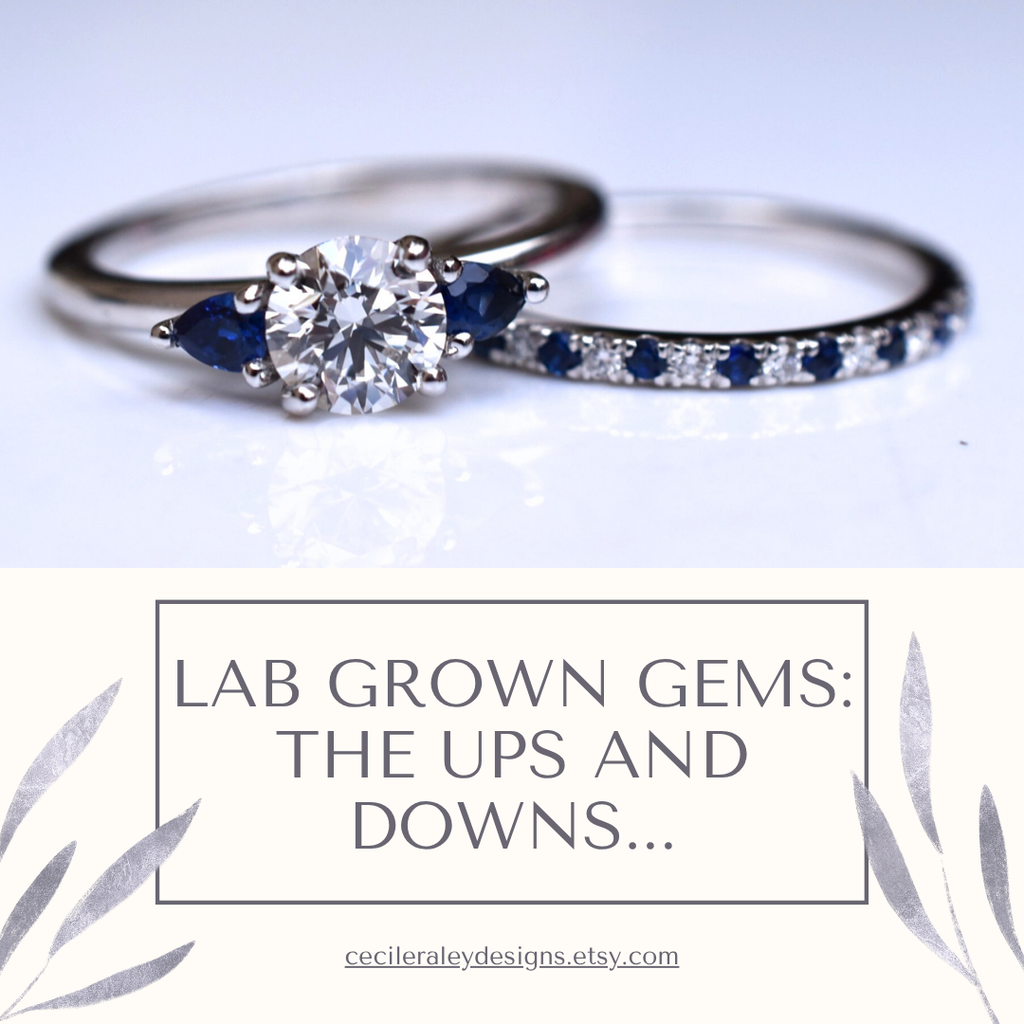Lab Grown Gems: The Ups and Downs...

Lab grown diamonds are all the rage these days. In recent years, their market share has increased to 20% of all diamonds sold globally, and more than twice that figure in the United States (46% according to the Berkshire Eagle). By 2032, lab grown diamonds are expected to grow by at least another 10% - or more. Lab grown diamonds offer a cheaper alternative to naturally grown diamonds, and the two look identical.
Here's a little background on lab grown diamonds: materially (chemically), lab grown gems are the exact same as natural ones. They are produced in just a few weeks by taking a small seed diamond and subjecting it to either CVD (Chemical Vapor Deposition or HPHT (High Pressure High Temperature) to create the final result. You can read more about these processes in an article here. This makes lab grown diamonds endlessly ubiquitous, compared to natural diamonds (which are not exactly rare either, at least not white diamonds). Lab grown diamonds have existed for over 70 years, but didn’t make it into the jewelry market until the 2000’s. Concerns over blood diamonds, the environment and demand for lower prices, all these factors have made the lab grown diamond a viable alternative to the real deal in many people’s eyes.

But is a viable alternative also a valuable one? Common sense already tells us that the answer to that has to be ‘no,’ Not only is ‘making a diamond’ virtually limitless, their manufacturing costs are lower than mining costs, and they do not involve geopolitics, which also lowers the production costs, as well as fluctuating prices due to risk. Lab diamonds are grown in India, China and the United States, all of which are stable economies compared to the countries where diamonds originate, such as the Ivory Coast. If you can make the product for less than you can mine it, and you can make as much of it as you want, then it will be cheaper but also less valuable.
Resellers of lab grown diamonds are well aware of this, and this is why the secondary market on lab grown diamonds yields 10% or less of the purchase price. Natural diamonds, by contrast, fetch 40-60% of purchase price in the secondary market.
When I am asked to make a piece of jewelry with lab grown diamonds, I wait to purchase the lab grown diamond until the very end of the production process because the longer I wait, the cheaper it gets. In fact, I order it, and I can get sidestones cut any which way as the cost of a 1 carat stone right now is about 20% that of a natural diamond but is constantly dropping (lab melees are also a small fraction of the price of natural ones). Whereas colored gemstones are rising in price and natural diamonds are stable, lab grown diamonds are getting cheaper and cheaper as their mass manufacturing improves.

I was once told that when you drive a newly purchased automobile off the lot, it loses 40% of its value. Given the resale value of natural diamonds, they lose about the same amount directly after purchase. (Gold, by contrast, will lose exactly the difference between markup and daily spot value, as it is a publicly traded commodity). This means that once you buy it, a lab grown diamond is worth 10% of what you paid should you want to sell it again.
Is that worth it? Absolutely not, unless you go into the decision with eyes wide open. If you prefer to avoid the ethical and environmental problems with natural diamonds, a Canadian diamond is an option and so are synthetic gems or diamond simulants (moissanite or cubic zirconia). Any of the non-natural material is more or less on a par as far as value is concerned, as we are talking about the difference between manufacturing and earth mined gems, meaning the difference between potentially unlimited and limited supply.
Apologies: this article includes basically no information on lab grown colored gems, which exist in equal variety and ubiquity as lab grown diamonds. The same rules apply – their value decreases drastically after purchase and the resale market will not reimburse the buyer. Lab grown colored gems do not have a large market share (yet), however. As demand for gems increases, I expect this to change, but we are not there now. Colored gems make up only a small share of the jewelry market in general, with diamonds being the world leader in terms of its revenue generated.
So: would I buy a synthetic or lab grown gem? Yes, sure. I just wouldn’t put it into gold jewelry. I would treat it as what it is: upscale costume jewelry. I would enjoy it but not consider it anything valuable. And as long as that is how you approach it, you will like your pretty piece and not worry about having to replace it or losing it, or even insuring it – insurance companies will insure these for lower premiums only because of their value, and they generally prefer not to.
The AGTA does not allow the sale of synthetic stones at its shows either (though members can sell them at other venues, i.e. in their stores or online). It aims to avoid confusion over the provenance of gemstones and intends to abide by its founding principles as a natural gemstone association. More about their decision is explained here.
At CRD, we source lab grown diamonds only upon request, but if you like to own one, you just need to let us know.
